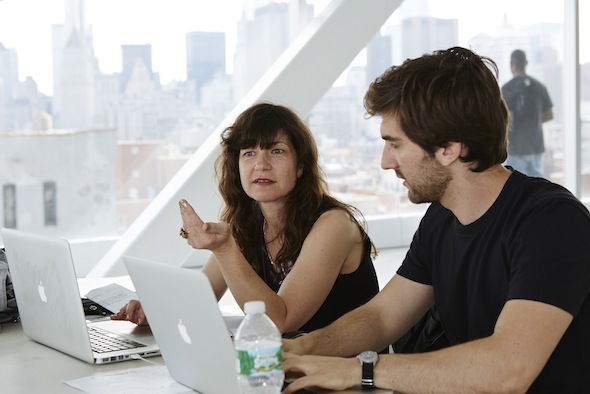
Frances Stark and David Kravitz during the Seven on Seven work day. Photo: Ed Singleton.
The fifth anniversary edition of Rhizome's Seven on Seven took place on Saturday. The project pairs seven leading artists with seven influential technologists in teams of two, and challenges them to develop something new–whatever they choose to imagine—over the course of a single day. The results were unveiled to the public on Saturday at the New Museum, and are recapped here.
In the keynote, Kate Crawford suggested that K-Hole's #normcore trend report, as well as the Snowden-leaked GCHQ Powerpoint, could be read as manifestations of the anxieties of an age of mass surveillance, those of the surveillers and those of the surveilled.
Blending in can give you a kind of power in 2014. This gets even more interesting when we think of the other groups that have recommended dressing like a tourist in New York City. Who am I thinking of? Occupy.
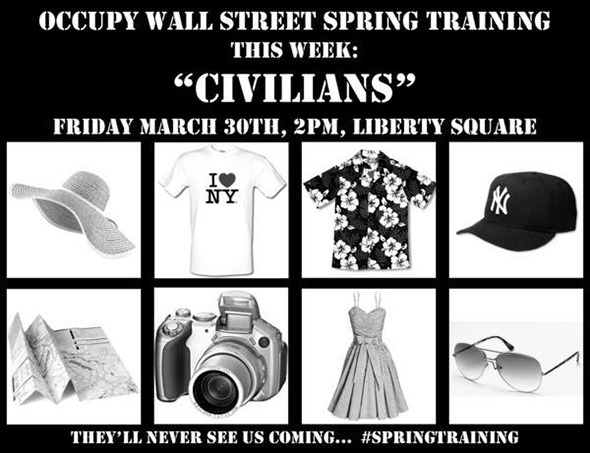

Top: Flyer for "#SpringTraining on Friday: Dress To Blend," March 30, 2012. Bottom: Image from YOUTH MODE: A REPORT ON FREEDOM by K-Hole and Box 1824, 2014.
"The cultural idea of disappearing," Crawford argued, "has become cool at the very historical moment when it has become impossible, because of Big Data."
#2. Promiscuity can be a metaphor for certain conditions of creative labor
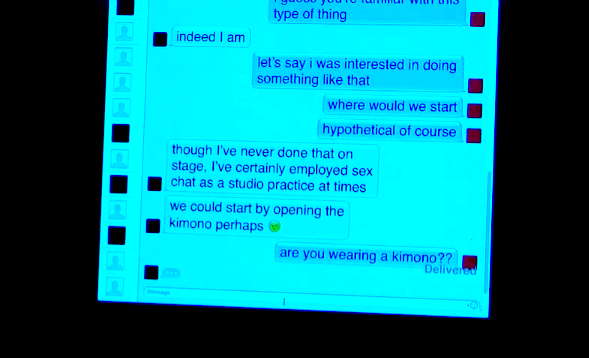
David Kravitz and Frances Stark delivered an absolutely unforgettable presentation via an onscreen chat in which they discussed the possibility of having sex on stage before getting to their real proposal: to cut out the middle man. Your move, TechCrunch Disrupt.
Actually, their real real proposal could be understood as a kind of analogy between sex and labor. While they joked about cutting out the middlemen, they came down squarely on the side of sex.
#3. Autocomplete is a tragedy (but there's hope)
"Google reflecting your own habits back to you," artist Kari Altmann noted, "is changing your habits in the process." Her project with Aza Raskin, who described this as the "tragedy of autocomplete," introduced softness and abstraction into the literal-minded world of the search engine.
They made a new search engine (which needs a name! suggestions welcome). After being fed a short sequence of images, it attempts to locate similar images on the internet. First, though, this fuzzy searcher attempts to recreate each source image. It finds itself unable to forget the other images it was given, so its recreations take the form of morphing variations and composites of its sources. It uses these abstracted versions to trawl Google Image Search, with happily unpredictable results.
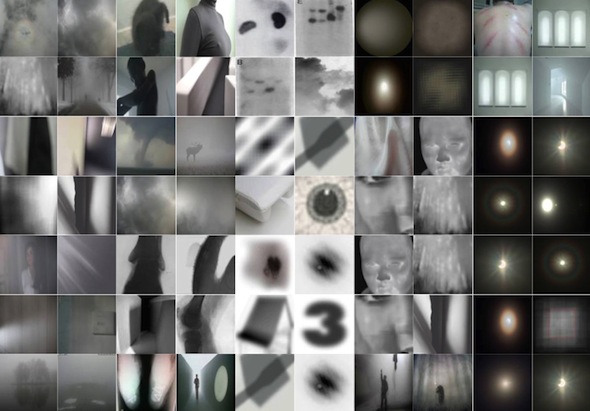
#4. Data has status in the eyes of humans
Ian Cheng and Jen Fong-Adwent aka Edna Piranha produced a BDSM-friendly icebreaker. In their smartphone-enabled game, participants in a social setting assume the role of master or slave, and must find their other half. Upon locating their partner, the participants would be asked to enter a mutually agreed safe word. (More about the project here.)
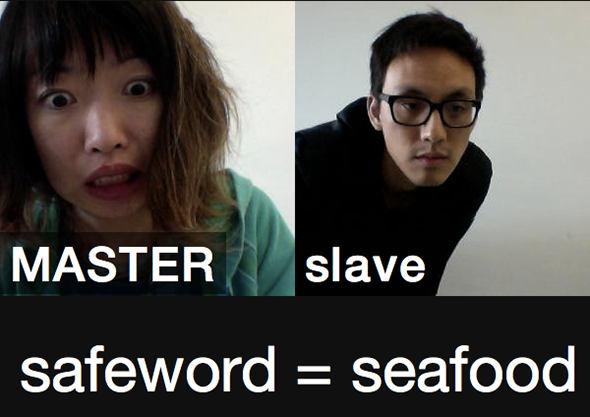
We didn't get to play at the conference because it was in demo mode only, but we all imagined what it would have been like, and it was happily carnivalesque and only mildly NSFW. But one of the interesting ideas to emerge from their conversation was that of data status—the idea that a piece of data like a safe word only has value because of the context conferred on it by humans. For example, the word "seafood" as a piece of data floating around Twitter doesn't have much status until we learn that it's actually Ian and Jen's safe word; in the context of their one day working relationship, that piece of data had very high status.
(As a side note, the word "user" came up several times at the conference because of concerns, initially voiced by Kate Crawford, that it uncritically reflects, even produces, technologically enabled asymmetries of power. Cheng and Fong-Adwent happily circumvented this argument by extending this asymmetry to its logical endpoint, the master and the slave).
#4a. Our data is more valuable to our loved ones than it could ever be to the NSA
I'm cheating with the numbering here, I know, but I think data status is a nice way to think about this next project too.
Holly Herndon and Kate Ray both approached their collaboration with the intent of making something that would foster greater intimacy through technology, age of mass surveillance be damned. They had several fantastic ideas (and I hope they someday make their email-related ones) but the one they built allows people having a text-based chat to take screenshots of one another at random moments. So you get to see someone in unguarded moments, beyond the duckface.
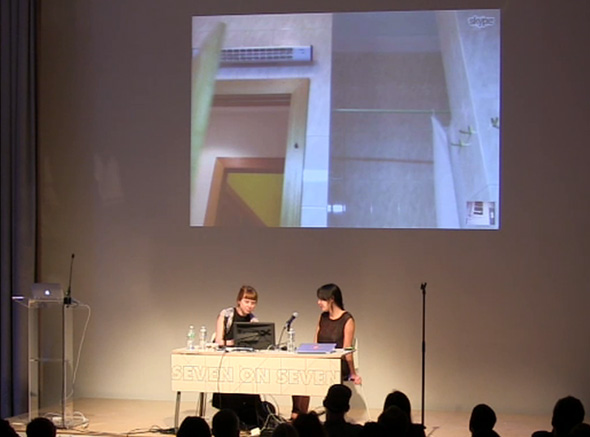
Herndon shared some of the screenshots that her life partner has taken of their Skype calls while she travels for music around the world. The images were of an empty room; she was presumably off getting ready or taking care of some mundane business of being on tour. Occasionally, the top of her partner's head was visible in the video chat window, looking very patient. The NSA might not get very much hard data from them, but in the context of their relationship they seem really sweet.
#5 The Spatial Montage Theory of Vine (or, painting with video)
Before we all had smartphones, the awkward, accidental cut was a staple of home video. By stopping and starting the camera strategically, one could create fake eyeline matches and hugely inappropriate juxtapositions of tone. It was Vine that re-introduced montage to the lexicon of home video. Where the smartphone camera generally creates a separate clip for each shot, Vine allows users to piece together their six-second videos from short fragments, the way moving image is supposed to be.

Sawbaum gif by Prosthetic Knowledge
In their collaboration, Avi Flombaum and Hannah Sawtell took this collage-esque logic a step further, not just assembling video fragments in time (through editing) but in the space of a web page as well. Their tool, Sawbaum, allows users to create pages out of many Vines, butted up against one another in what Lev Manovich would call a spatial montage (as opposed to temporal montage of video editing).
Sawtell said she liked these sharp juxtapositoins the best, but the tool is intended not just for spatial montage, but for what Avi described as "painting with video," using layers and transparency to blend multiple sources together in fluid compositions.
#6 A contented, secure employee with the agency to use his paid hours to pursue compelling, if off-topic work, will draw the news better than a precarious worker
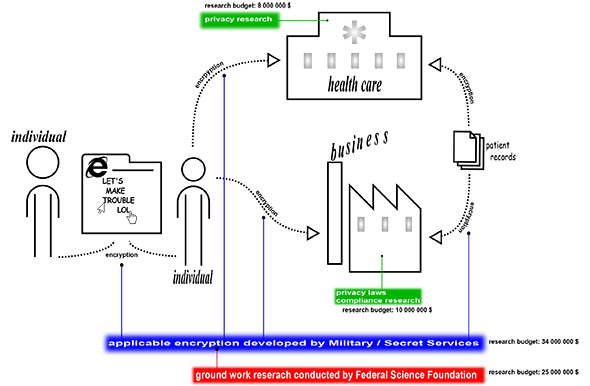
An excellent drawing by Rhizome Conservator Dragan Espenschied
On Friday, Simon Denny and Nick Bilton sent the recent US Government Big Data report out to Rhizome's staff and community, as well as via TaskRabbit and other networks of precarious workers. The experiment was a modest intervention into the cascade of information that constitutes today's news; drawing requires a contemplative but analytical frame of mind that is about as far from continuous partial attention as it gets. But what emerged from the project, in part, was the reality that this kind of frame of mind is something of a luxury. Only the privileged can take both eyes off the cascade.
#7 The blockchain can be used to establish ownership and provenance of digital art
Every article about cryptocurrency that I've read in the last year, and that's a lot of articles, includes some version of the sentence, "the greatest potential of bitcoin is the new forms of collective behavior it can potentially enable." Exciting! But for the most part, it doesn't seem to have really happened, yet.
This new project by Anil Dash and Kevin McCoy might be a way of giving the cryptocoin community something useful to do. Monegraph uses a cryptocurrency (Namecoin) to record the owner of any given digital artwork. Thus, artworks sold via monegraph use the blockchain (the shared database of all transactions that makes cryptocurrency possible) to preserve information about the title of an artwork; it's like proof-of-provenance for GIFs.
McCoy and Dash used Monegraph to sell this GIF onstage for the contents of Anil's wallet ($4). He's now registered as the owner of this GIF in the public Namecoin blockchain:
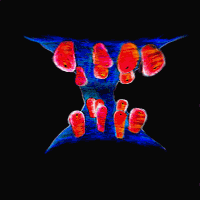
Dash has already had an offer, but he's not sure if he wants to flip it just yet.
The full video of Seven on Seven 2014 is available here.


